My mother Helen Bennett née Ritchie's family from Australia/Scotland
John Ritchie was Steve's great-great-grandfather. His third son, also named John, was born in Fife, Scotland on 4th April 1834. This son married Annie Gullon in 1861 at Leuchars, Fifeshire when he was working as a Farmservant. They had seven children and he died in 1907 from cancer of the liver. His occupation at that time was recorded to be Railway Serviceman. His youngest child was a son William Ritchie who was born in 1876.
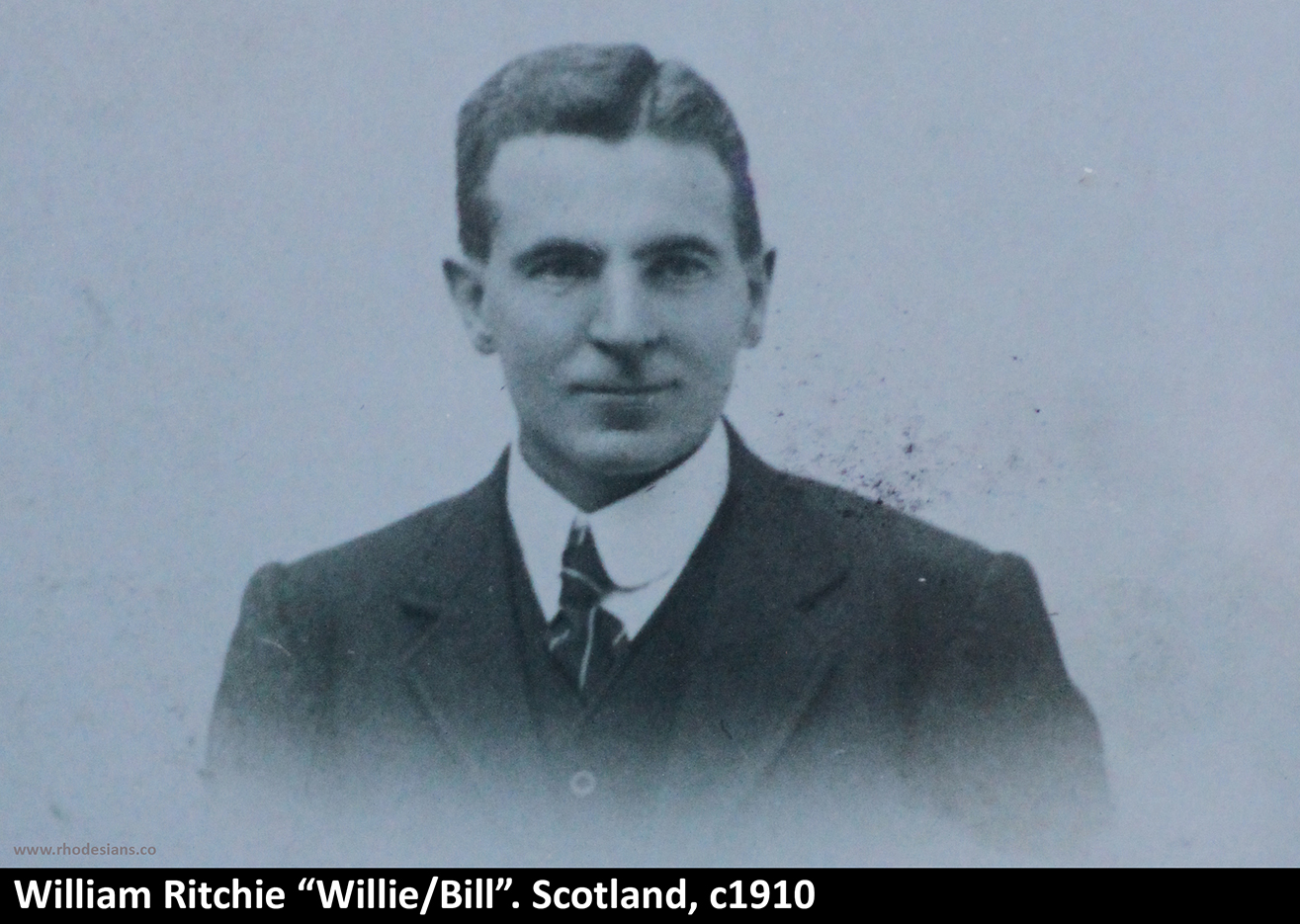
William, known as Willie, qualified as a Marine Engineer and he married Betsy Donaldson. Her parents were Robert Donaldson and Mary Christie and she was working as a school teacher in the “Normal” school in Glascow at the time. Robert was a Carriage-builder (Journeyman). He bred and showed canaries and always had a long walk on Sundays. Tragically his body was found at about 6:45 p.m. on 6th October 1912 after he had drowned in the Forth and Clyde Canal at the age of 66 years.
After sailing the globe with work, Willie decided to settle in Sydney for a fresh
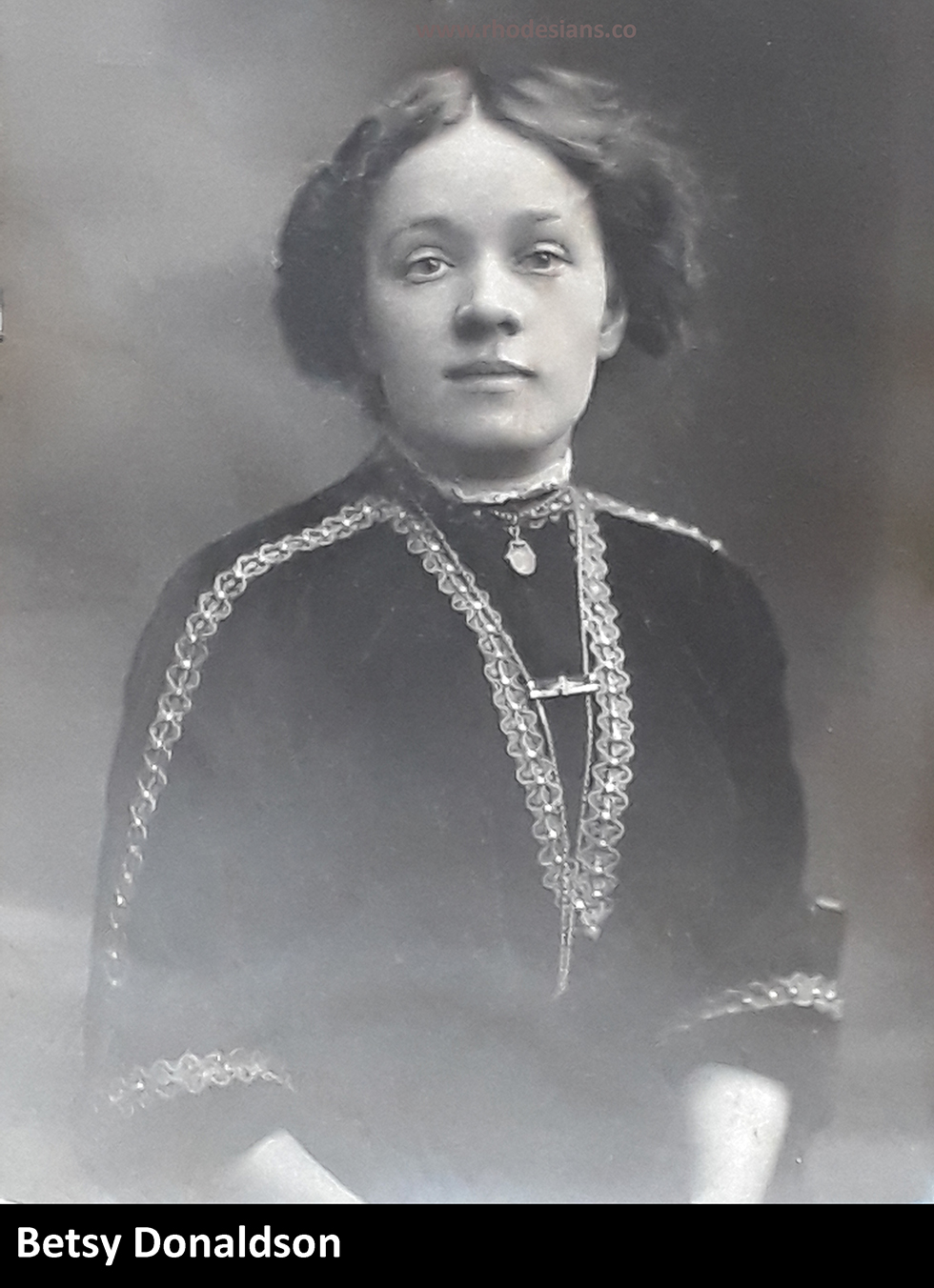 start. Betsy left her residence at 23 Meldrum Road, Kirkaldy and joined him with her widowed mother, Mary Donaldson.
start. Betsy left her residence at 23 Meldrum Road, Kirkaldy and joined him with her widowed mother, Mary Donaldson.
The family moved into Darley Street, North Sydney and Mary passed away there. She was buried exactly seven years after Robert had drowned. Willie was working on the ferries that crossed Sydney Harbour and they moved to 28 Riverroad West, Lane Cove. He was retrenched after the Sydney Harbour Bridge had been opened and they moved to 72 Kenneth Street in Longueville.
They were in contact with Betsy’s younger brother, Charles Donaldson, known as "Charlie". Charlie had served with the ‘South African Scottish Regiment’ which was the fourth regiment of the 1st South Africa Infantry Brigade during the 1914-18 war. He married Isobel Dunbar who was a nursing sister and may have come from Aberdeen. Charlie owned Donaldsons Bakery in the eastern districts of Rhodesia.
Willie visited Rhodesia but wasn't permitted to take a job that any Rhodesian could do 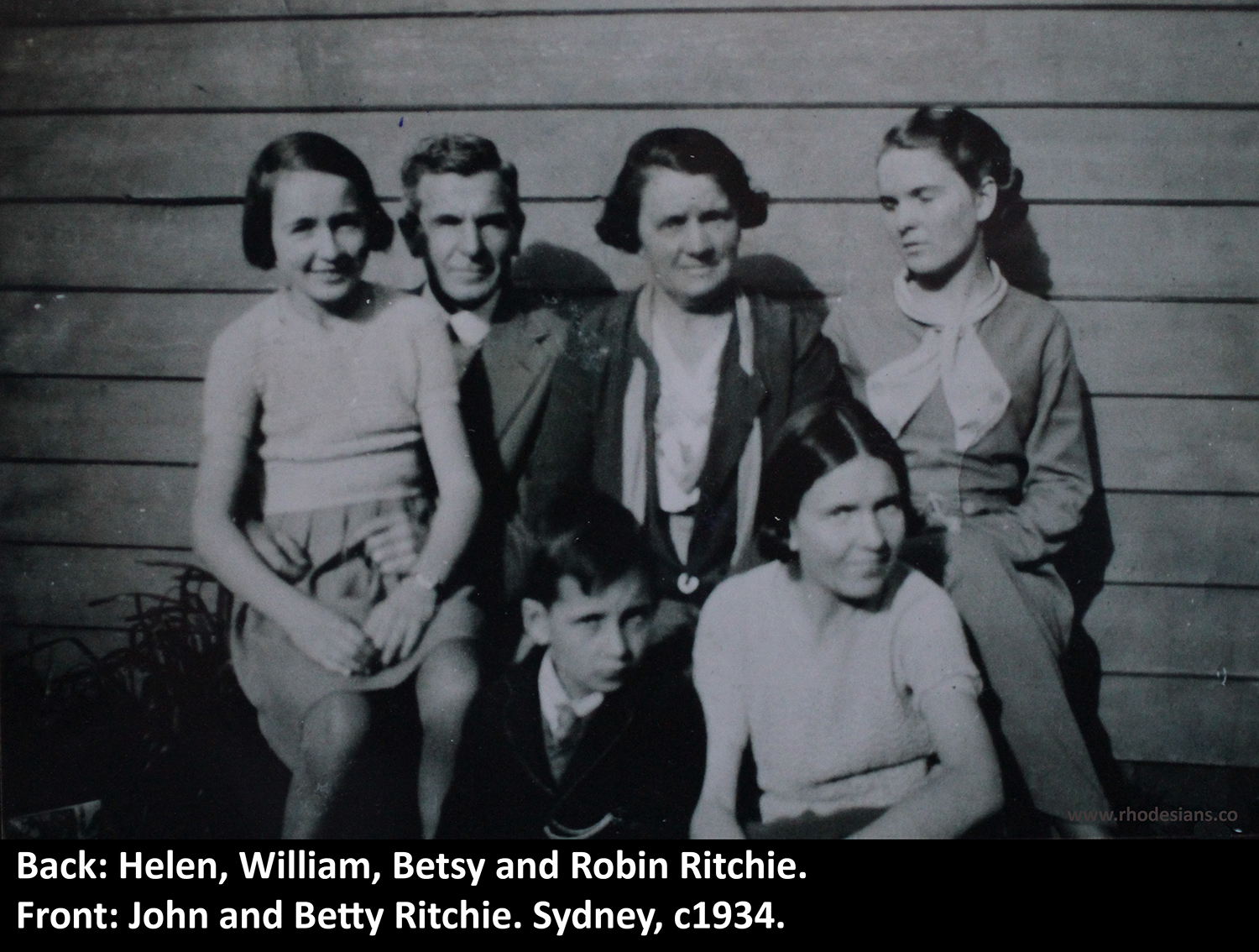 because the depression had extended there too. He took up a position on a ship as an engineer to Belgium and Japan and returned to Sydney in 1933.
because the depression had extended there too. He took up a position on a ship as an engineer to Belgium and Japan and returned to Sydney in 1933.
“Uncle Charlie” assisted the passage for the family to move on Themistocles which took two weeks to sail from Sydney to Fremantle on the West Australia coast, then another two weeks to reach Durban in August 1935. Three children Derek, Vernon and another from the Caddy family sat at the Ritchie table. Vernon described Helen “Long in the legs, thick in the head, Australian born, Australian bred”.
The eldest daughter Mary (known as Robin) remained in Sydney to finish university and to teach for three years. Helen had to pass an exam in order to enrol at North Sydney Girls High and was in her first year of senior school when she left. Heather Scott and Norma Larsen were her friends. All the pupils in her class had contributed cash to buy stationery which filled half of the trunk which she was allowed to take over.
Charlie had booked them into the Seaton Hotel in Durban. They then sailed on to Beira on Dunbar Castle where Charlie met them dressed with a bowtie and put them on the train to Umtali.
When in Umtali, Willie worked on the power station for Rezende Mine at Penhalonga that drew water from the Odzani River. Helen and Betty schooled at 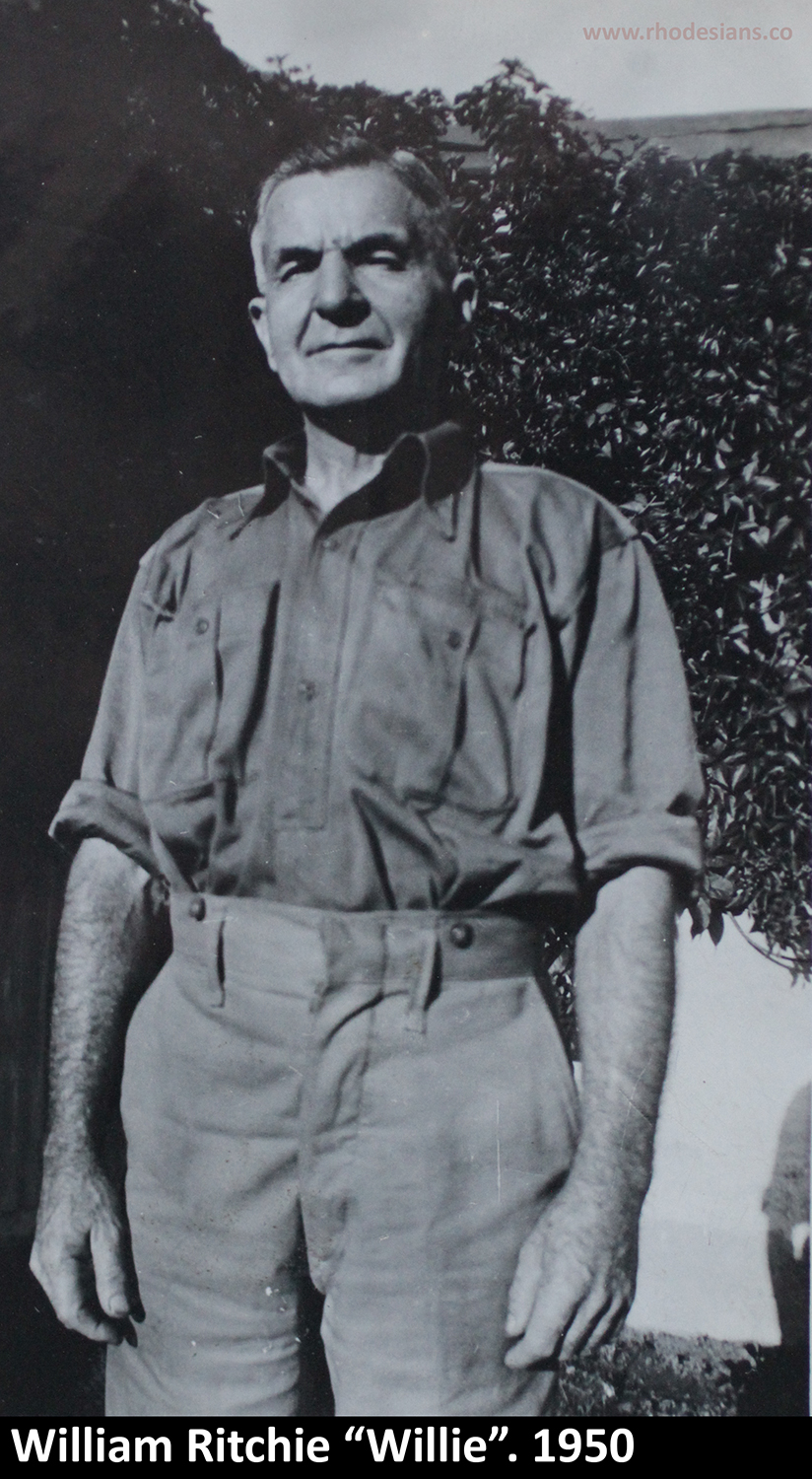 Umtali High for two terms before moving to the Midlands.
Umtali High for two terms before moving to the Midlands.
Willie got work at Golden Ridge Mine at Que Que. Helen went to Que Que School and got raw eggs for breakfast as the stove wasn’t working. She ran away from the school to join her parents before they left for Salisbury. She was then sent as a border at Chaplin in Gwelo where she settled down and enjoyed it.
Helen Ritchie
Willie worked at Crasters in Salisbury and stayed at the Queens Hotel. Meanwhile, the family returned to Umtali. Helen was going to study a commercial course at the Umtali Convent but she got a scholarship to study Education at Rhodes University in 1939. The following extract is in ‘The history of Umtali Girls’ and Boys’ High Schools 1896-1968’:
“B du Preez and Helen Ritchie gained First class passes in 1938. A Tapson who gained a Class Two was also awarded a Beit University Bursary.” 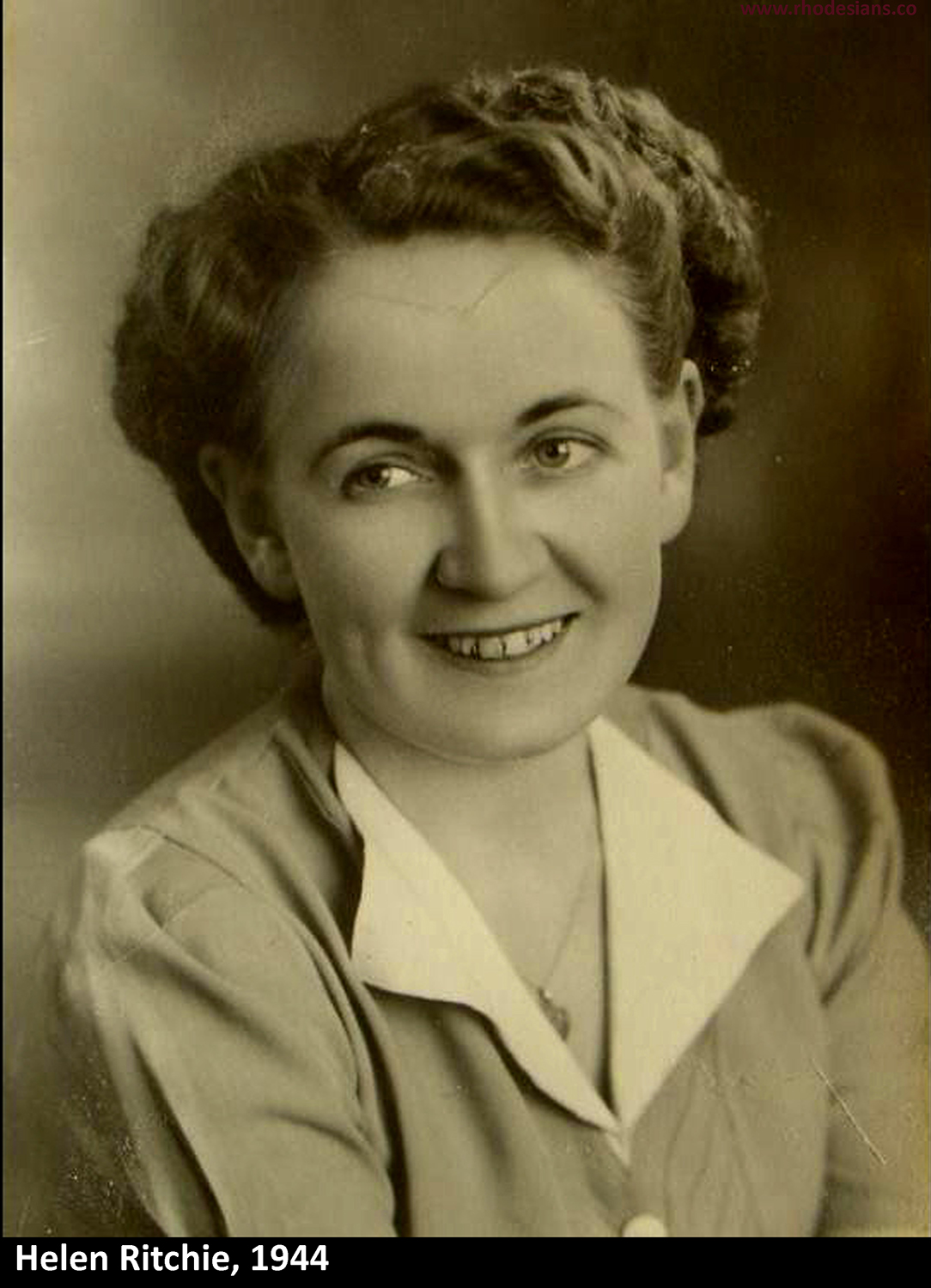
When Helen went to Rhodes University the family moved to Odzani where Willie worked at the Odzani Power Station. John boarded at Umtali High after studying by correspondence at Que Que. Betty had attended the convent at Gwelo and started a Commercial Course. She continued in Umtali and worked at the Umtali Advertiser.
Helen played hockey and was in Oriel Residence, then moved into Jameson and finally to Beit Residence. She wanted to major in French and Maths but couldn’t speak French fluently so she did a Latin and Maths major. She completed a BA and then completed the UED in 1942. Brian Armitage had been her boyfriend in first year, then Peter Sharpe in second year – he was killed in WWII.
At the end of the second year, she met a B Comm student Dennis Bennett on the train who felt sorry for her during her long stop on the journey on to Umtali during a vacation. He invited her home for breakfast. Apparently his parents approved of her but they only started going out the following year.
Helen and Dennis became engaged in 1943 before he went of to WWII. They married in Umtali in September 1946, only a few weeks before her eldest sister Robin married Terence Fynn "Terry", also in Umtali. A record of the Bennett family can be viewed by clicking here.
Robin was the oldest child that had survived. Another may have been born before her because a name was scratched out in the family Bible. Anne was born two years after Robin but she passed away from diphtheria aged four years, after Betty and Helen had been born. John Ritchie was the youngest and he was ten years younger than Robin. 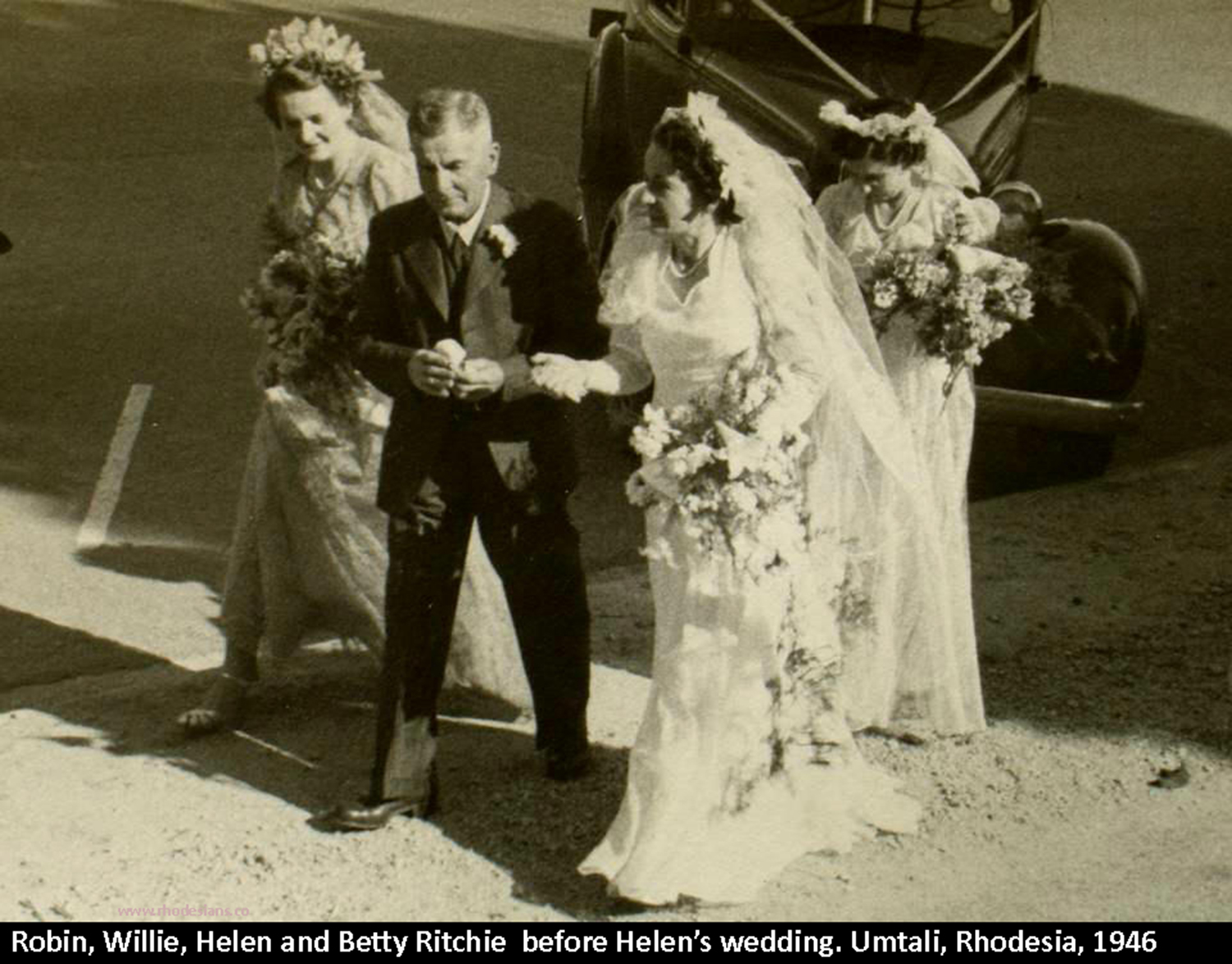
John Ritchie
John went directly from Umtali Boys High School to train for two years in the air force as WWII had broken out by then. He commenced at Initial Training Wing (ITW) at Hillside in Bulawayo on 13th October 1943, then 25 Elementary Flying Training School (EFTS) at Belvedere from February the next year. He proceeded to 20 Service Flying Training School (SFTS) in Cranbourne which he completed in January 1945. He was sent to 71 Operational Training Unit (OTU) in Ismailia, Egypt for two months, then a month at No 5 RFU at MACAF in Italy. In his logbook the Group Captain Commanding officer recorded “Instances of avoidance by exceptional flying skill and judgement of loss of life or damage to personnel or an aircraft”. The details are recorded: “At the moment of take-off from Gaudo Aerodrome on 11th June 1945, the bearing of the Spitfire port tyre failed. This allowed tyre and tube to be “detached” completely and fall off leaving bare the main wheel hub. While circling the aerodrome the pilot Sgt Ritchie was given the option by the Commanding Officer of making either a belly or a one wheel landing. He elected to do the latter, and came in making an excellent single wheel landing without damage to the aircraft or runway”.
His final posting was to 334 Wing, MAAF until 14th August 1945. It took until the end of 1945 before he returned home.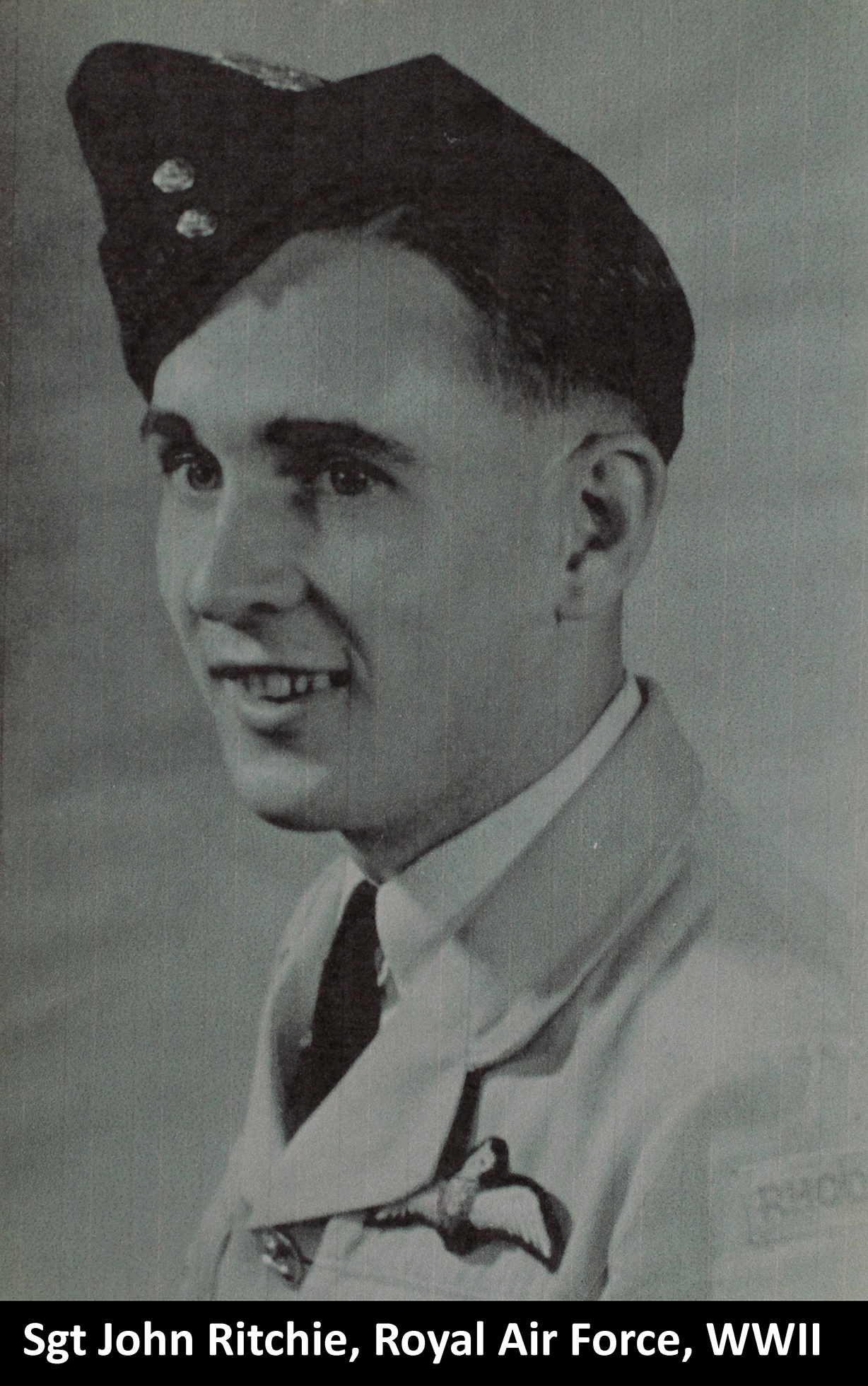
He enrolled to study architecture at Cape Town University in 1946.
John went to his fellow student Anthony (Tony) Kristafor's 21st party. He duly escorted his fellow student date back to her residence at 11:00 p.m. but returned to the festivities to see Patricia Schreiber, known as “Pat”, who he had earlier met. She was working with an insurance company in Cape Town and they started seeing each other after that. Her parents sent her to work in Johannesburg but the two corresponded daily and married in Claremont in 1949.
John’s first job after qualifying was with Ayers, Wilson and Parker in Bulawayo in January 1950 and they lived in Hillside. He moved to Salisbury in September to join Ross McKenzie, van Heerden and Hardford.
In 1960 the Australian government wanted architects so John applied. The family moved to Australia in January 1961 and Pat was with him with David, Jocelyn, Peter and Mark. John worked in Sydney for two years then moved to Bathurst where Andrew was born.
They returned to Sydney in 1965 where he built that delightful house that hung onto the edge of the steep slope in Wahroonga.
Mary Ritchie
Willie and Betsy’s eldest daughter, Mary Ritchie, known as Robin, had taught at The Rock Central School near Wagga Wagga after completing her studies in Sydney. After that she joined her family that had moved to Rhodesia after Willie had been retrenched.
Gertrude May Jenkinson, known as “Maisie”, had taught her daughter Kate and two other girls at the school that she opened. It was named after the farm ‘Chisipite’, some 180 hectares in extent that her husband had bought when he retired as a Land Surveyor. Robin was engaged to Ian Jenkinson, their son, but he was killed in WWII.
Dennis and Helen Bennett had bought the house on Dover Road and the Jenkinsons lived on the corner with North Road on a large block of land that they had retained. Dennis often played tennis there on Sundays and the family played in the large garden and swam. The African Grey Parrot and turkeys always got attention from the kids.
Returning back to the mid-1940s, Robin was teaching at Rusape School where she met Terence Fynn, known as "Terry", who was spending his season on a tobacco farm on his return from WWII service. Terry was the eldest son to be born in Kingwilliamstown but his father became District Commisioner in Gatooma, Fort Victoria and Chimanimani. Terry went to St Georges when it moved from Bulawayo to Salisbury in 1927. He was a welterweight champion boxer at school then went to the UK to study as a Jesuit priest at Heythrop. He opted to join the Air Force when WWII broke out and flew Lancaster bombers during the war. He had successfully completed 30 missions then was sent to train pilots in Canada for a break.
He returned to Europe and was flying with 44 Squadron. After a bombing raid he was returning when he thought that he had been hit by ground fire as he saw his craft crash in flames while he was parachuting down. After capture as a prisoner of war he was puzzled during interrogation at Stalag Luft III as he was asked about airmen that he didn’t know.
The mystery was solved much later when documents from Germany revealed that two British bombers had collided. Terry's Lancaster had collided with a "Pathfinder" Lancaster. The Pathfinder hadn't fully released its cargo of flares so had turned back without altering altitude so was travelling at the wrong height for that direction. Terry Fynn's radio operator, Jimmy Moran, was found in the wreckage of the Pathfinder that crashed two kilometres away but the Germans never explained this to the prisoner. Terry was also treated by suspicion by the British prisoners because there was no one else there from his aircraft as he was the sole survivor from his aircraft so the British suspected he could have been planted by the Germans as a spy.
After one season at Rusape, Terry and Robin married in Umtali in September 1946. He took over Chikanga Farm next to the Beri River at Gadzema as a Returned Serviceman. He opened the virgin farm and grew maize and tobacco. Mangoes were sold as a cash crop in Hartley. Terry and Robin have four sons – Hugh, Mick, Paddy and Donald.
Terry's elder sister, Daphne, married the Northern Rhodesian governor Sir Arthur Benson. Terry's younger brother, Henry, had four sons - Paul, Tim, Nick and Anthony. His cousin, Jack Fynn was a mica miner from Chitaki River, Chiwore, Zambezi, had four children - Kerry, Francis, Tommy and Mike.
After Willie retired, he and Betsy stayed in a cottage on Chikanga Farm. Willie passed away in 1957, aged 81; and Betsy passed away one year and one day later.
Terry Fynn is a descendant of William McDowall Fynn. William is the younger brother to Henry Francis Fynn and their father was Irishman Henry Francis Fynn who came from Doncaster. The family tree is presented below:
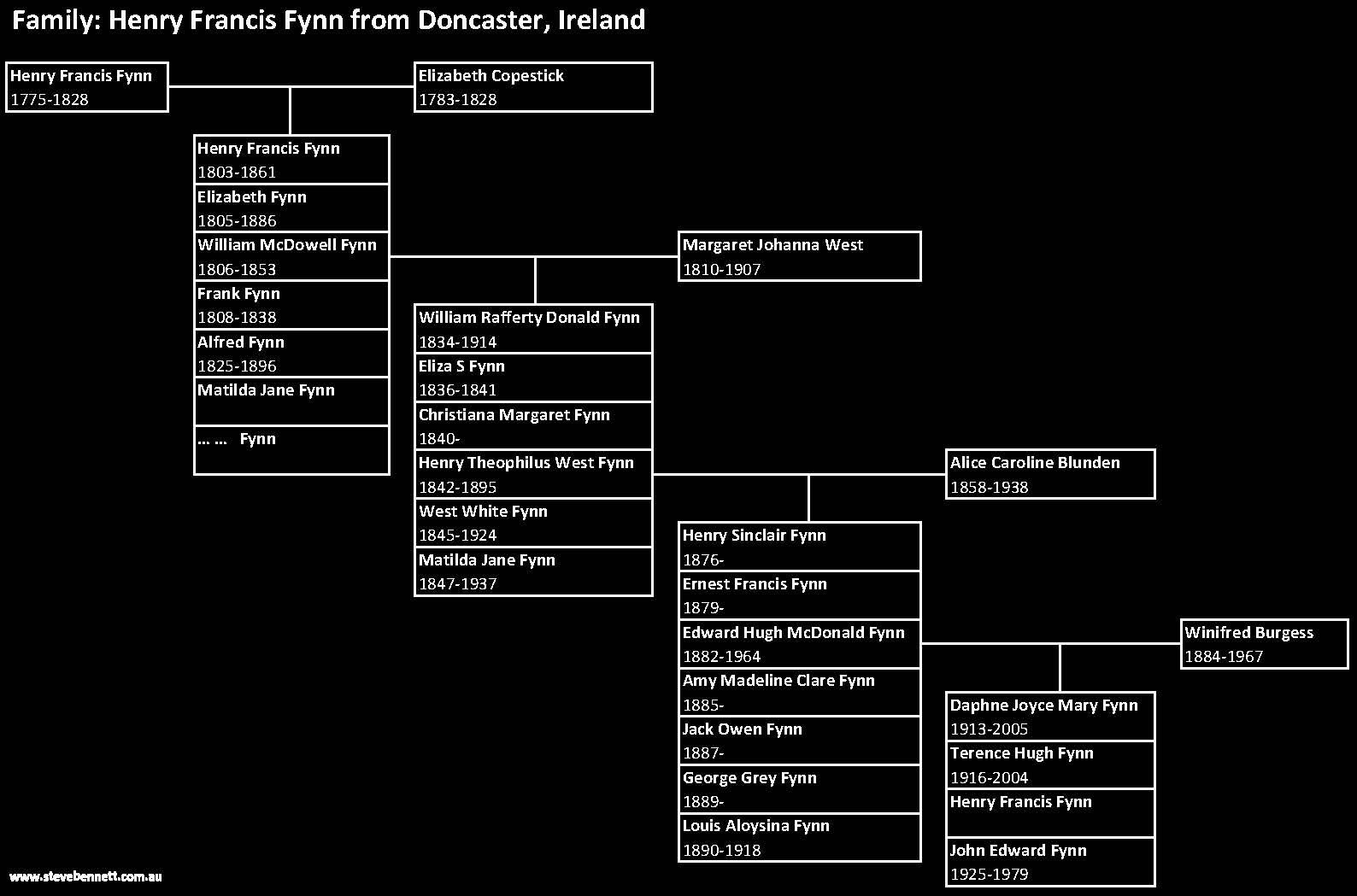
William was born on 21st July 1806 in Grosvenor Square, London to Henry Francis Fynn and his wife Elizabeth (née Copestick). Henry went from England to the Dutch East Indies (India) and acquired considerable wealth as a trader. However, the Cape Government, then under the Dutch East India Company, confiscated his ship and assets on the grounds that Indian coin could not be exported from the Cape. William moved after his baptism with his parents and older sister to Cape Town where his parents opened the 'British Hotel' in Long Street in October 1806. They had left their eldest son, Henry Francis Fynn, with an aunt in London.
William accompanied Captain Aitcheson to the Zulu chief Shaka and then he went to the Portuguese Settlement “Lourenço Marques” in Delagoa Bay in search of the survivors of a wrecked ship. Having succeeded, he remained there for five years trying to mitigate the suffering of the Fengu clans by Zulus. They were Xhosa whose 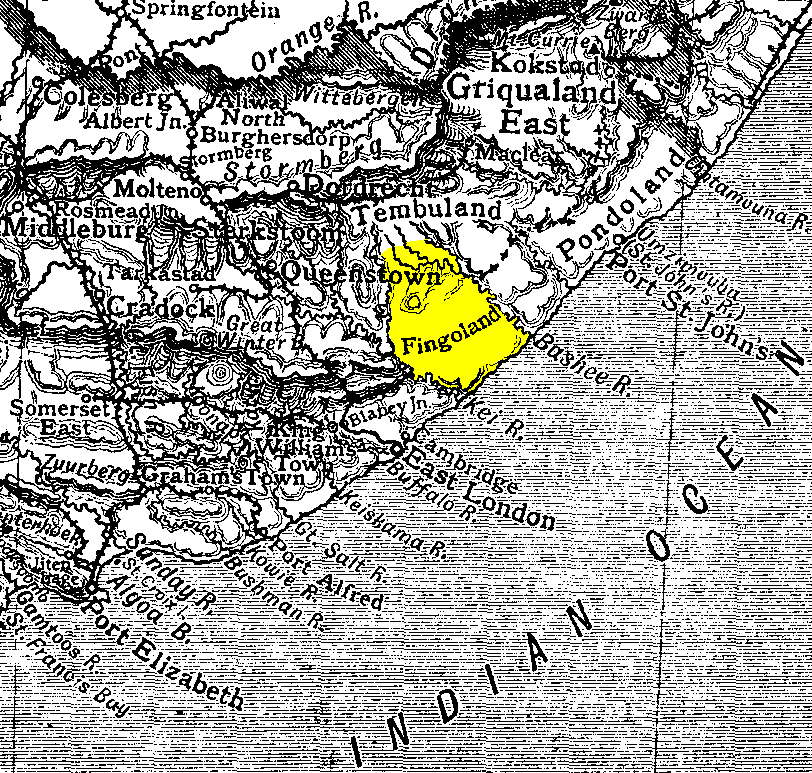 ancestors were refugees that fled from the Mfecane and originated near the Embo river. After 25 of his party had been killed by the Zulus and his property destroyed, William departed.
ancestors were refugees that fled from the Mfecane and originated near the Embo river. After 25 of his party had been killed by the Zulus and his property destroyed, William departed.
He was appointed again in 1834 in the Commissariat Department and when the Zulu war broke out in 1835, William was appointed Superintendent of the Fengu clans, Interpreter and acted as provisional Quarter-Master in the 75th Regiment and 72nd Highlanders.
During the Early Frontier Wars, the Fengu became allies with the Cape Colony against their former foes. William and Sir Harry Smith went unarmed to meet chiefs Macomo, Tyli, Suto, Eno etc in the Keiskama bush. William was left as the hostage but that dispute was resolved after he had almost been shot by 200 armed warriors when they became startled.
When Chief Umhala needed to be placated, it was William Fynn that Col Smith sent.
In 1838, William amicably settled a dispute between Faku, the Gaikos and the Tembos and war was prevented on the border. In 1846 all his property was destroyed but the Chief of the Tambookies with 400 armed men had saved them. William stayed with them during that war in the hope that his presence might deter fresh conflict. It took forced marches by Lt Col Eyre to finally bring relief to William.
William died at his house in King Williams Town on 6th June 1853. He had served in remote territory through prolonged conflict and had sustained a bayonet wound to the back. Despite letters of approbation for his service to successive Governors, his wife with the five surviving children was denied a grant or a pension.
His older brother, Henry, had remained in the UK with an aunt after the parents had moved to South Africa with the infant William and his older sister. Young Henry completed his education at the public 'Blue Coat School' in London in
1816. He completed two years as a surgeon‘s apprentice and followed the family to the Cape in 1818.
After working for four years for Robert Hart at 'Somerset Farm', he was offered a position by Henry Nourse and Company as supercargo on 'Jane' a trading vessel to Delagoa Bay with responsibility for the selling of the cargo and he had to purchase a return cargo.
Over six months he had ventured into Natal and sought a meeting with Shaka with the intention of securing ivory at the source. Henry's arrival in Natal in 1824 opened up a new channel of commerce by circumventing the Portuguese and Arabs and linked Natal and Zululand.
Henry built a strong rapport with the ruthless Zulu Chief and his basic medical knowledge had served twice as an opportune ice breaker. The security of traders was assured down to Port Natal and Henry engaged in trading and hunting. He extended his activities far into the interior in search of ivory, accompanied by Zulus.
Shaka gave Henry nine girls for marriage. Henry kept six and gave three to Frank, the brother that is two years younger than William.
Henry's great wife in 1824 was the Zulu Princess Mavundlase (also written by historians as Vundhlase). She originated from the Zelemu clan. A mixed race community from the 20 first generation descendants remained in Natal after Henry left his brother Frank and returned to the Cape. Those that chose to be classified as Coloureds had higher status in the Republic but they found themselves distanced from Shaka's heritage which apparently was not a birth right. Morris Fynn, a direct descendant from Henry and Mavundlase, was laid to rest as a Zulu chief at the ancestral home at Umzumbe in 2015.
In 1832, Henry Francis Fynn returned to the Cape Colony and five years later he married Ann Brown in Grahamstown but she died aged 21. Two years later he married Christina Brown, who may have been Ann's younger sister, aged 20. The historian Julie Pridmore writes that Christina and her father, John Brown, were from Zwartkop in Algoa Bay, where she was born in 1821. Henry and Christina had a son in 1846 named Henry Francis Fynn Jr.
Henry Francis Fynn returned to Natal in 1852, where he worked as a resident magistrate and died in Durban in September, 1861.
Betty Ritchie
Betsy Ritchie was known as "Betty". She worked at the Umtali Advertiser after doing a commercial course.
On 28 December 1947, she married Reginald Krahner, known as "Chips" and "Reg", who was a painter with Rhodesia Railways.
Reg was one of seven in the Krahner family. There was also Fred, Anthony "Barney", Peter, John, Winnie and Ismay "Bubbles". John had tragically died in a shooting accident on their farm in Banket when he was still quite young. The longest to survive was Peter who passed away in 2016.
Reg had been posted to reconnaisance in the Air Force and processed photographs that had been taken by pilots in Ian Smith’s squadron in Italy during WWII. They married in Umtali in December 1947 and had four children – Jeanette, Les, Ken and Albert.
When the Rhodesian Prime Minister, Ian Smith, was visiting the late young Ken Krahner's school in Salisbury, the PM stopped when he saw Ken. He asked if they had met before. Ken was surprised and said that they hadn't. The PM was puzzled so asked him his name.
When he was told that it was Kenneth Krahner, he asked "Are you the son of Reg Krahner?"
It is extraordinary how Ian Smith had noticed a familiarity in a random schoolboy with his father that he had last seen as an airman 20 years previously in WWII in Italy.
Reg passed away in 1976 aged 58 and Betty five years later aged 61.